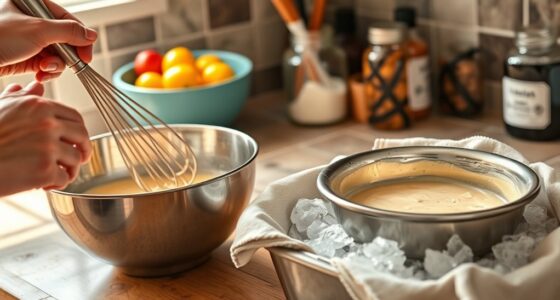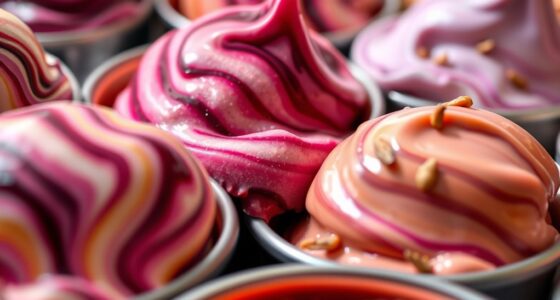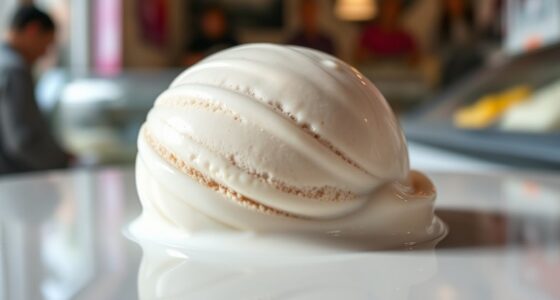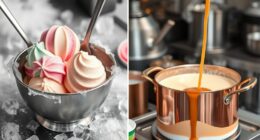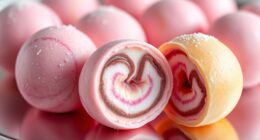To extract maximum flavor with zero bitterness using cold infusion, start with fresh, high-quality ingredients and slice or prepare them properly. Use a sealed container with cold water or neutral solvent, then steep for 8 to 24 hours, gently stirring periodically for even infusion. Longer steeping enhances flavor without bitterness, thanks to low temperatures that prevent tannin extraction. Keep your ingredients cool and dark during this process—continue exploring for more tips to perfect your technique.
Key Takeaways
- Use cold water and extended steeping (8-24 hours) to maximize flavor extraction while preventing bitterness.
- Select fresh, high-quality ingredients and prepare them properly to enhance flavor infusion.
- Gently stir or agitate the mixture periodically to ensure even extraction without over-bittering.
- Strain solids once desired flavor intensity is reached to avoid over-extraction and bitterness.
- Store in a cool, dark place to preserve delicate flavors and prevent degradation during infusion.

Cold-infusion techniques offer a gentle way to extract flavors and nutrients from ingredients without applying heat, making them ideal for delicate herbs, fruits, and teas. This approach relies on a slow, controlled process that prevents bitterness and preserves subtle nuances often lost with hot brewing methods. When you choose a cold brew method, you’re prioritizing smooth, nuanced flavor extraction over rapid extraction, allowing the ingredients’ true essence to shine through without the harshness that heat can cause.
Cold infusion gently extracts flavors without heat, preserving delicate nuances and preventing bitterness for a smooth, refined taste.
To begin, you select fresh, high-quality ingredients, understanding that their quality directly influences the final taste. The process involves immersing these ingredients in cold water or a neutral solvent, then letting it sit for hours or even overnight. This extended steeping time is key to achieving maximum flavor extraction without bitterness. You don’t need to worry about over-extraction, as colder temperatures naturally inhibit the release of tannins and other bitter compounds that hot brewing can often extract. Instead, you allow the flavors to gently seep into the liquid, resulting in a clean, refined profile.
Your choice of brew method depends on the ingredients and the desired outcome. For herbs and delicate flowers, a simple infusion in cold water or alcohol works best. Fruits can be sliced and added to water, creating naturally flavored beverages or spirits. Teas, especially green or white varieties, benefit from cold infusion to preserve their delicate notes. As you prepare, keep in mind that the longer you let the ingredients steep, the more intense the flavor becomes. However, patience pays off—most infusions are ideal after 8 to 24 hours, depending on the ingredient.
During this process, you should verify the container is sealed and stored in a cool, dark place. This prevents light and warmth from degrading the flavors or encouraging unwanted microbial growth. You might find it helpful to gently agitate or stir the mixture occasionally, promoting even flavor extraction. Once the infusion reaches your preferred strength, strain out the solids, and you’re ready to enjoy a beverage that’s rich in flavor yet free from bitterness.
Cold-infusion techniques are particularly advantageous because they allow you to enjoy complex, nuanced flavors without the bitterness often associated with hot brewing. You get a cleaner, smoother taste that highlights the natural qualities of your ingredients. Whether you’re making herbal teas, fruit waters, or spirits, this method ensures your final product captures maximum flavor with minimal bitterness. It’s a simple, effective way to elevate your infusions, giving you a revitalizing, well-rounded experience every time. Additionally, understanding the science behind flavor extraction helps optimize your process for the best results.
Frequently Asked Questions
Can Cold-Infused Drinks Be Made With Hot Ingredients?
You might wonder if cold-infused drinks can be made with hot ingredients. Typically, cold infusion involves using lower temperatures to extract flavor without bitterness, but hot infusion uses heat to speed up the process. With proper temperature control, you can start with hot ingredients and then cool the mixture to preserve delicate flavors. Just be careful to avoid over-extraction, which can lead to bitterness and muddled taste.
How Long Can Cold-Infused Beverages Be Stored?
Think of a cold-infused beverage like a delicate flower; it needs care to last. You can typically store it for 3 to 5 days in the fridge, but beyond that, spoilage risks increase. Proper storage duration is key to keeping flavors vibrant without risking bacteria growth. Always check for off smells or cloudy appearance before enjoying, as freshness diminishes over time.
Are There Specific Containers Best for Cold Infusion?
When choosing an infusion vessel, you want a container that’s non-reactive and durable. Material selection is key—glass and stainless steel are ideal because they won’t impart flavors or degrade over time. Avoid plastics that can leach chemicals. Your vessel should have a tight seal to prevent contamination and maintain freshness. Properly selecting your infusion vessel guarantees your cold-infused drinks stay flavorful and pure without bitterness.
Does the Type of Water Affect Flavor Extraction?
You’ll find that water mineralization and water temperature considerably affect flavor extraction. Using mineral-rich water can enhance taste, but too much mineral content might introduce bitterness. Cold water temperature slows extraction, helping to pull maximum flavor without bitterness, especially during infusion. So, choose water with balanced mineralization and maintain a consistent cold temperature to achieve ideal flavor without unwanted bitterness in your infusion process.
Can Cold Infusion Be Used for Non-Beverage Foods?
Sure, why not infuse your salads or desserts? Cold infusion isn’t just for drinks—you can pair fruits to enhance flavors at the perfect infusion temperature. Just imagine, strawberries soaking in mint-infused water, or herbs quietly jazzing up your cheese. It’s a sneaky way to elevate non-beverage foods, pulling maximum flavor with zero bitterness. Who knew that the secret to gourmet cuisine was lurking in your cold brew setup?
Conclusion
By mastering cold-infusion techniques, you can reveal vibrant flavors without the bitterness often found in traditional methods. Sure, some might think it takes too long, but the wait is worth it for the pure, smooth taste you’ll enjoy. Plus, it’s incredibly easy—no heat, no fuss. So next time you want a flavorful, bitterness-free drink, give cold-infusion a try. You’ll be amazed at how simply you can elevate your beverage game with just a little patience.


